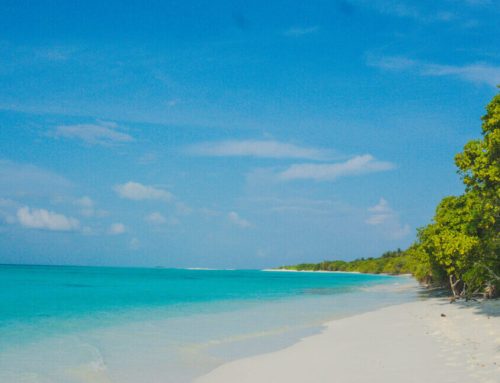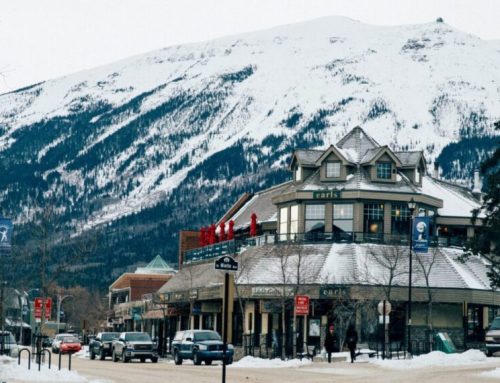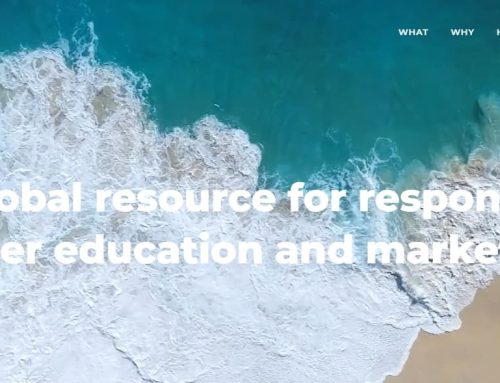Destination Stewardship Report – Summer 2023 (Volume 4, Issue 1)
This post is from the Destination Stewardship Report (Summer 2023, Volume 4, Issue 1), a publication that provides practical information and insights useful to anyone whose work or interests involve improving destination stewardship in a post-pandemic world.
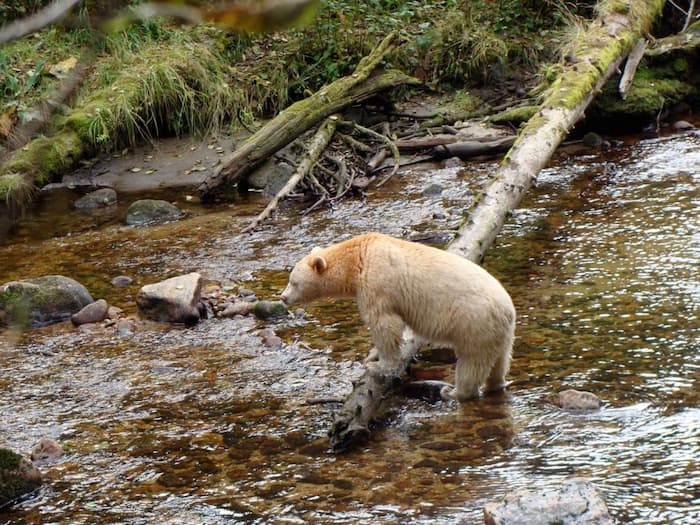
A Spirit Bear scans the shallow creek for running salmon. It is believed that only about 400 Spirit Bears exist in the world. [Photo by Mike Robbins]
Indigenous Guardian Programs as a Destination Stewardship Tool
Indigenous Guardian Programs in the Great Bear Rainforest and Haida Gwaii of British Columbia are emerging as powerful tools for destination stewardship. Developed by local Indigenous communities, these Guardian Watchmen programs play a critical role in protecting and managing traditional territories, preserving cultural heritage, and fostering a thriving conservation economy. Mike Robbins tells us more.
Indigenous Guardian Programs as a Destination Stewardship Tool
The first time I experienced Coastal Guardian Watchmen on the British Columbia coast was back in 2009 on a trip to an ancient village site and hot springs in Haida Gwaii. The local indigenous Guardians took turns living in the small remote Guardian cabin at Gandll K’in Gwaay.yaay (Hotspring Island). These Guardians were there to protect the site and cultural features, monitor tourism activity, and provide cultural interpretation.
The Guardian Watchmen on Haida Gwaii were some of the first members of an Indigenous Coastal Guardian Watchmen program, working alongside a strong Indigenous ecotourism sector in BC. Together, they have reconnected the Indigenous communities to their traditional territories, and that plays a critical role in all aspects of stewardship along the entire coast.
BC’s Guardian Watchmen are at the leading edge of a global movement toward Indigenous-led destination stewardship.

Along the coast of B.C.’s expansive Great Bear Rainforest. [Photo by Mike Robbins]
The Great Bear Rainforest and Haida Gwaii
The Guardians operate in the Great Bear Rainforest (GBRF) and Haida Gwaii regions of British Columbia, encompassing the largest intact coastal temperate rainforest remaining in the world. Stretching along BC’s coast north from Vancouver Island to Alaska, the GBRF covers 6.4 million hectares (15.8 million acres). This is an area rich in biodiversity with ancient old-growth forests providing home to a multitude of species including grizzly bears, black bears, and the iconic Spirit Bear. Spirit bears are rare white or cream-coated black bears with colouration caused by a recessive gene. They inhabit onl a small portion of the Great Bear Rainforest.
Twenty-seven First Nations live along this coast, many in communities accessible only by air or water. The rich Indigenous cultures have evolved over the past 10,000 years since the ice receded, living in harmony with the landscape.
Colonialism changed that, forcing the Indigenous peoples away and out of their traditional territories to make way for a lucrative economy, largely based on logging, fishing, and shipping, but with minimal benefit accruing to the First Nations.
A Conservation Economy
In 2016 the Premier of BC and First Nations of the GBRF announced a conservation agreement of global significance securing:
- 85% of the rainforest is legally protected (North America’s most stringent commercial logging regulations in place on the remaining 15%)
- First Nations shared decision-making over their traditional territories
- Active support from forestry companies and environmental organizations
This agreement culminated following years of collaborative protests, market campaigns, land use planning, and negotiations orchestrated by environmental groups and First Nations.
Today this incredible intact Canadian wilderness area hosts a thriving conservation economy (an economy that sustains itself on income earned from activities that conserve and restore rather than deplete the natural capital).
The Guardian Watchman Program
Guardian Watchmen programs vary from Nation to Nation in the GBRF depending on their priorities. Activities typically include:
- Scientific data collection and analysis
- Upholding and advancing cultural knowledge
- Restoration work
- Monitoring fish and wildlife harvests
- Emergency response
- Tourism monitoring and protocol agreements with non-Indigenous companies
- Planning and management
- Education and interpretation for visitors
There is a lot of overlap in the work and skill sets of Guardians who monitor and protect their territories and tourism guides who bring guests out on the territory to view wildlife, see archaeological sites, and learn from storytellers. In the GBRF there is work progressing towards a combined Guide/Guardian training designation to support growth in the conservation economy.
The Kitasoo Xai’Xais Model

Marvin, Guardian and Spirit Bear guide. [Photo by Mike Robbins]
As part of their stewardship efforts the community created the Spirit Bear Research Foundation, a collaboration between the community and conservation scientists, together conducting research that is: community-driven, locally relevant, and ecosystem-based.
The people of Klemtu do not view any separation between the people, the land and the sea. Every living thing is interconnected.
As tourists started to arrive at Spirit Bear Lodge back in 2006 the village’s youngsters began to take an interest and started to drop by in the evenings to chat with guests. Out of this initial connection was borne the concept of Sua, a Kitasoo/Xai’Xais youth cultural program sponsored by the Lodge. Sua is a Xai’Xais word meaning thunder, and the youngsters now involved in the program are encouraged to be ‘loud and proud’ in sharing their identity and culture as they stage song and dance performances in the Big House for guests of the Lodge. Further accommodating youth, the community decided to integrate a new conservation arm of the Nation called SEAS (Supporting Emerging Aboriginal Stewards) with the guardian and tourism programs.
Today the community of Klemtu is benefitting from a thriving ecotourism venture and guardian programs that have helped to protect their traditional territories, act as a catalyst for cultural renewal, and helped in re-connecting community members back to their ancestral territories. The result is a healthier community, building capacity, and engaging youth in learning cultural traditions and language.
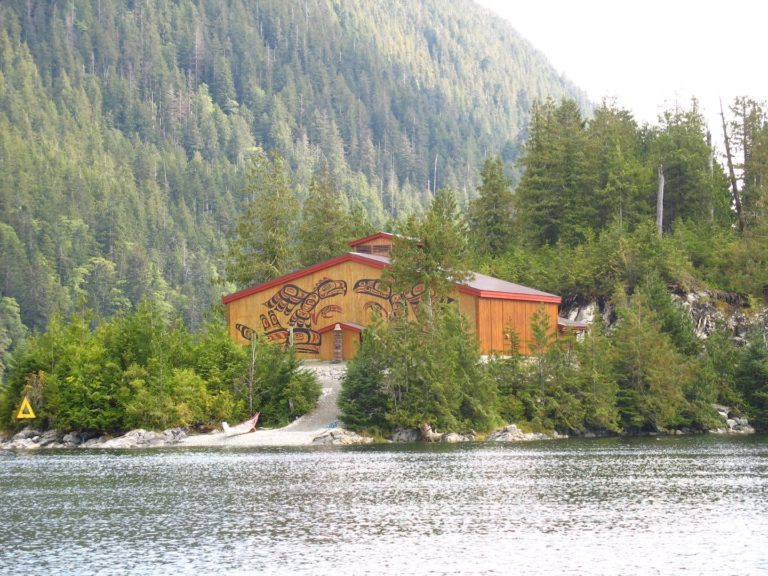
The Klemtu Big House, a symbol of Kitasoo/Xia’xias culture and resilience. [Photo by Mike Robbins]
The Wei Wai Kum First Nation Model
Another southern GBRF First Nation, the Wei Wai Kum First Nation, many of whom live on reserve in Campbell River, are monitoring and gathering data in their traditional territories through a Guardian program launched in 2018.
Through their Guardian program, the Wei Wai Kum are applying traditional knowledge and using scientific techniques to carry out their stewardship responsibilities in a modern way, keeping watch over what’s happening and ensuring that visitors and resource users are following local rules.
Today, within their traditional territory, several industries from fish farms to forestry to real estate are competing for resources and space. The Discovery Passage, which narrows to just 750 metres wide in some parts, runs along the northeast coast of Vancouver Island and sees heavy traffic from cruise ships, cargo ships, fishing boats, and passenger ferries. Community members began expressing concerns over resource depletion, spill risks, and environmental impacts that could threaten the fisheries the community has relied on for generations.
Through Nanwakolas Council, the regional Indigenous organization, the Wei Wai Kum receives a large and increasing number of referrals each month for consultation on development and resource use within their territory. As a member of the Council, Wei Wai Kum began to participate in the Nanwakolas regional stewardship network, which provides technical, logistical, and data management support for Indigenous Guardian programs in the region. Wei Wai Kum stewardship staff members participate in training and joint monitoring initiatives with other Na̲nwak̲olas members, learning how to run a modern Guardian program.
As an example, Wei Wai Kum Guardians conduct a kelp biomass survey in their territory. Kelp is an important habitat, food source, and carbon sink – and has been declining along the coast, due to climate change and increased predation from purple sea urchins.
The Benefits of Guardian Programs
Research suggests that places protected and stewarded by Indigenous peoples in Canada, Australia, and Brazil have levels of biodiversity as high or higher than lands protected by those countries’ national governments.
In 2016 research conducted by Coastal First Nations and Nature United evaluated the benefits of Guardian programs for their communities. The research determined that the programs returned benefits at least 10 times the dollar investment. As a result, Nature United helped develop an Indigenous Guardians Toolkit and through a Technical Support Team are offering additional hand’s-on technical support.
Indigenous communities across Canada have launched more than 30 guardian programs modeled after the successful Coastal Guardian Watchmen program in the GBRF and Haida Gwaii.
This model could be replicated in many other destinations where Indigenous communities still remain and can resume their historical stewardship role in their traditional territories, resulting in healthier communities, engaged youth, and enhanced capacity for research and tourism.
About the Author
Mike retired as Chairman of the Board of Directors with CREST (The Center for Responsible Travel) based in Washington DC in December 2021. Mike is part of the TAPAS Group network (IUCN Tourism and Protected Areas Specialist Group) holds numerous other positions, including Board Member for the Aspiring (UNESCO) Georgian Bay Geopar,Member of the Trebek Council, Board Member of the Escarpment Corridor Alliance, Fellow of the Royal Canadian Geographic Society, Fellow International Member of the Explorers Club, and Royal Penguin LT&C (Linking Tourism & Conservation).


